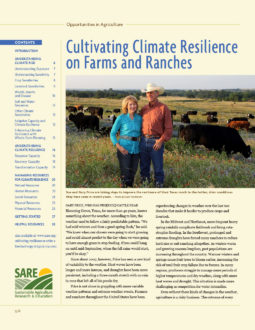Farmers and ranchers are experienced managers accustomed to making tradeoffs between goals and available resources. Because risk management has traditionally focused on using financial and technological tools to reduce production risks, many farmers and ranchers have less experience with the risk management benefits of their other resources. Operating a farm or ranch with an eye toward reducing climate risk means taking a broader look at how all of your resources under management—natural, human, social, physical and financial—can contribute to the response, recovery and transformation capacities of climate resilience.
Resilient farmers and ranchers take advantage of the climate risk benefits provided by the full range of resources under management, including:
- natural resources such as healthy soils that buffer extremes of rainfall and temperature
- human resources such as a creative, effective and climate-literate management team that can identify challenges and opportunities, and act accordingly
- social resources such as a supportive community that supplies high-quality, reasonably priced goods, services and labor, and is home to profitable markets
- physical resources such as the infrastructure, equipment and technologies needed to support management goals
- financial resources such as a net income that sustains the farm business and supports a high quality of life for the people who live and work on the farm
In addition, combining complementary practices from these different resource types will allow you to enhance climate resilience far beyond each practice used by itself.
For example, healthy soils (natural) capture and store large amounts of water (natural), and so they reduce the need for irrigation (natural, social, financial and physical). They also sequester carbon from the atmosphere (natural); decrease production costs by reducing the need for such inputs as fertilizers, pesticides and water (financial); increase product quality (financial and social); and reduce the environmental impacts of production (social). As another example, diversified marketing can increase income (financial) and strengthen relationships with both communities and local and regional buyers (social).

